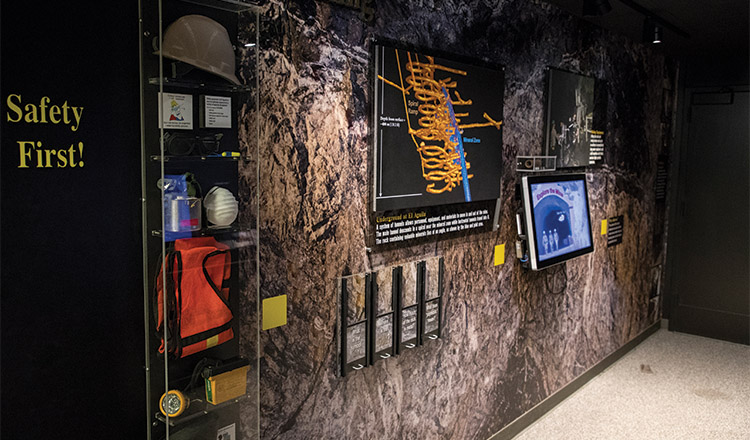On the second floor of the Delon and Elizabeth Hampton Hall of Civil Engineering, a museum-quality exhibit transports visitors to another realm: the El Aguila Mine near Oaxaca, Mexico.
The Department of Earth, Atmospheric, and Planetary Sciences (EAPS) mining exhibit, constructed in 2013, occupies a short hallway and two adjacent walls, and it has all the interactive and multimedia trappings of a top-notch museum display. Four touchscreens display educational videos and offer games based on the exhibit’s facts. Photos, display boards, and bright graphics present information in easy-to-understand chunks. Bedrock samples, safety equipment, raw minerals, and other items taken from the mine are displayed in cases, and the hallway’s facade is even decorated to look like a mining tunnel.
The exhibit’s purpose is to educate Purdue students and visiting youngsters about mining. The industry is infrequently discussed in science curricula, but its jobs are open to many with EAPS degrees.
“Part of the goal with this exhibit is to shed light on one of the unique ways alumni can put their EAPS degrees to work,” Steven Smith, EAPS outreach coordinator, says. “Mining might not seem very accessible to most students, but this exhibit proves that, with the right degree, anyone can enter that or any other related industry if they simply have the desire.”
The funds to build the mining exhibit came from Bill Reid (S’70, MS S’72), former chief executive officer of Gold Resource Corporation based in Colorado Springs, Colorado. The company owns El Aguila Mine, and Reid is an EAPS alumnus and Indiana native. The exhibit’s high quality can be attributed to the Purdue Agriculture Exhibit Services Center, which put it together.
El Aguila Mine gathers and refines several kinds of ore, including copper, gold, tin, and silver. Reid and three EAPS faculty and staff traveled to southwestern Mexico to gather pictures, data, rock samples, and other items from the mine for the exhibit.
The resulting exhibit presents information chronologically. Its first display presents geological facts about the formation of ore, including plate-tectonic and volcanic activity. The exhibit then discusses mining safety, mining techniques, information about processing ore, efforts to sustain the environment, and careers in mining and other fields related to geoscience.
What are your favorite hidden gems on campus? Let us know in the comments.

